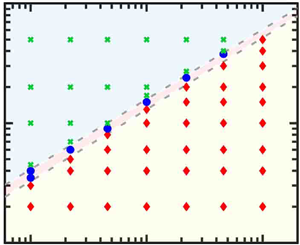Published online by Cambridge University Press: 15 February 2022

External modulation on thermal convection has been studied extensively to achieve the control of flow structures and heat-transfer efficiency. In this paper, we carry out direct numerical simulations on Rayleigh–Bénard convection accounting for both the modulation of wall shear and roughness over the Rayleigh number range  $1.0 \times 10^6 \le Ra \le 1.0 \times 10^8$, the wall shear Reynolds number range
$1.0 \times 10^6 \le Ra \le 1.0 \times 10^8$, the wall shear Reynolds number range  $0 \le Re_w \le 5000$, the aspect-ratio range
$0 \le Re_w \le 5000$, the aspect-ratio range  $2 \le \varGamma \le 4{\rm \pi}$, and the dimensionless roughness height range
$2 \le \varGamma \le 4{\rm \pi}$, and the dimensionless roughness height range  $0 \le h \le 0.2$ at fixed Prandtl number
$0 \le h \le 0.2$ at fixed Prandtl number  $Pr = 1$. Under the combined actions of wall shear and roughness, with increasing
$Pr = 1$. Under the combined actions of wall shear and roughness, with increasing  $Re_w$, the heat flux is initially enhanced in the buoyancy-dominant regime, then has an abrupt transition near the critical shear Reynolds number
$Re_w$, the heat flux is initially enhanced in the buoyancy-dominant regime, then has an abrupt transition near the critical shear Reynolds number  $Re_{w,cr}$, and finally enters the purely diffusion regime dominated by shear. Based on the crossover of the kinetic energy production between the buoyancy-dominant and shear-dominant regimes, a physical model is proposed to predict the transitional scaling behaviour between
$Re_{w,cr}$, and finally enters the purely diffusion regime dominated by shear. Based on the crossover of the kinetic energy production between the buoyancy-dominant and shear-dominant regimes, a physical model is proposed to predict the transitional scaling behaviour between  $Re_{w,cr}$ and
$Re_{w,cr}$ and  $Ra$, i.e.
$Ra$, i.e.  $Re_{w,cr} \sim Ra^{9/14}$, which agrees well with our numerical results. The reason for the observed heat-transport enhancement in the buoyancy-dominant regime is further explained by the fact that the moving rough plates introduce an external shear to strengthen the large-scale circulation (LSC) in the vertical direction and serve as a conveyor belt to increase the chances of the interaction between the LSC and secondary flows within cavities, which triggers more thermal plumes, efficiently transports the trapped hot (cold) fluids outside cavities.
$Re_{w,cr} \sim Ra^{9/14}$, which agrees well with our numerical results. The reason for the observed heat-transport enhancement in the buoyancy-dominant regime is further explained by the fact that the moving rough plates introduce an external shear to strengthen the large-scale circulation (LSC) in the vertical direction and serve as a conveyor belt to increase the chances of the interaction between the LSC and secondary flows within cavities, which triggers more thermal plumes, efficiently transports the trapped hot (cold) fluids outside cavities.
To send this article to your Kindle, first ensure no-reply@cambridge.org is added to your Approved Personal Document E-mail List under your Personal Document Settings on the Manage Your Content and Devices page of your Amazon account. Then enter the ‘name’ part of your Kindle email address below. Find out more about sending to your Kindle. Find out more about saving to your Kindle.
Note you can select to save to either the @free.kindle.com or @kindle.com variations. ‘@free.kindle.com’ emails are free but can only be saved to your device when it is connected to wi-fi. ‘@kindle.com’ emails can be delivered even when you are not connected to wi-fi, but note that service fees apply.
Find out more about the Kindle Personal Document Service.
To save this article to your Dropbox account, please select one or more formats and confirm that you agree to abide by our usage policies. If this is the first time you used this feature, you will be asked to authorise Cambridge Core to connect with your Dropbox account. Find out more about saving content to Dropbox.
To save this article to your Google Drive account, please select one or more formats and confirm that you agree to abide by our usage policies. If this is the first time you used this feature, you will be asked to authorise Cambridge Core to connect with your Google Drive account. Find out more about saving content to Google Drive.